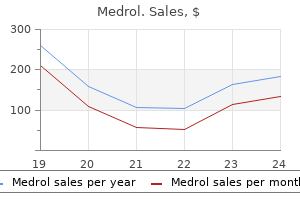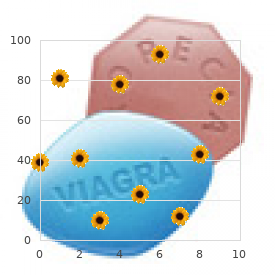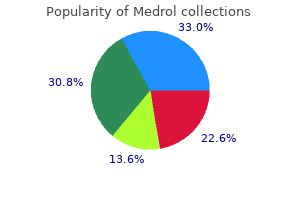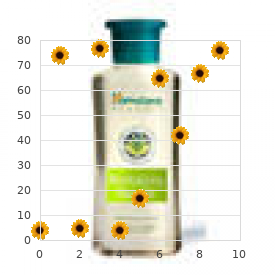Only $0.59 per item
Medrol dosages: 16 mg, 4 mg
Medrol packs: 30 pills, 60 pills, 90 pills, 120 pills, 180 pills, 270 pills, 360 pills
In stock: 561
9 of 10
Votes: 222 votes
Total customer reviews: 222
Description
B Recommendation High-risk patients should be monitored as inpatients postoperatively arthritis knee drug 16 mg medrol purchase overnight delivery. B Recommendation Patients should be reevaluated postoperatively to determine whether further treatment is required. B Recommendation Weight loss is recommended in addition to other therapy in patients who are overweight or obese. Both patent areas, as well as areas that are intermittently or continually collapsed, can be identified. The clinician should ascertain if the patient has had any overt apneas, witnessed choking episodes while asleep, daytime somnolence, enuresis, or hyperactivity. Although the etiology of this association is unknown, it has been speculated that compensatory lymphoid hypertrophy of the tonsils and adenoid occurs secondary to autosplenectomy. A Cochrane review published in 2011 investigating antiinflammatory medication for obstructive sleep apnea in children identified only 2996 three applicable studies. Additional rare complications include velopharyngeal insufficiency and nasopharyngeal stenosis. To minimize these risks, a thorough preoperative evaluation is necessary, including assessment for bleeding diatheses, evaluation of clinical factors associated with postoperative respiratory difficulties, and determination of risk for postoperative hypernasality. In a series of 206 patients undergoing solely adenoidectomy, 80% of children had an improvement in symptoms. Regrowth of adenoid tissue, especially in children less than six years of age, can result in recurrence of obstructive symptoms and likely contributes to the previously noted high rate of revision adenoidectomy. Hypertrophic lymphoid tissue at the base of the tongue may contribute to airway obstruction. The risk of oropharyngeal stenosis can be reduced by refraining from concurrent palatal surgery. Tongue reduction using radiofrequency ablation has been shown to improve Epworth Sleepiness Scale and respiratory disturbance index with minimal complications in adults. Hyoid suspension is intended to reduce the posterior shifting of the tongue which occurs while sleeping in the supine position. Children with craniofacial abnormalities may benefit from specific procedures to correct these anatomical deformities. Children with midface hypoplasia may undergo Le Fort osteotomies with midface advancement. A thorough evaluation of craniofacial anatomy and neuromotor status is necessary to determine candidacy for such procedures.

Linoleic Acid (Flaxseed Oil). Medrol.
- Are there any interactions with medications?
- Dosing considerations for Flaxseed Oil.
- Rheumatoid arthritis.
- How does Flaxseed Oil work?
- What is Flaxseed Oil?
- Constipation, cancer, anxiety, prostate problems, vaginal problems, weight loss, attention-deficit hyperactivity disorder (ADHD), high cholesterol levels, and heart attack prevention.
- Are there safety concerns?
Source: http://www.rxlist.com/script/main/art.asp?articlekey=96951
Premature spillage is the escape of material over the tongue base in the absence of purposeful oral transfer before the initiation of swallowing arthritis medication list order 4 mg medrol with visa. The degree of spillage needs to be evaluated with respect to the ability of the patient to initiate a clearing swallow. Premature spillage of a volume sufficient to start filling the pyriform sinuses is of concern, as it may increase the risk of aspiration. It is, however, important to note that premature spillage is not always indicative of an abmormal swallow and may reflect a normal developmental pattern of swallowing; infants often trigger the swallow from the level of the valleculae. Laryngeal penetration is the passage of food material or secretions into the endolarynx. If food material pools in the hypopharynx, it may rise to a level at which the natural barriers protecting the endolarynx are breached. The significance of laryngeal penetration depends on the volume of material entering the larynx and the frequency of penetration events. Thin materials have a greater likelihood of flowing through the glottis than do thick materials. Frequent laryngeal penetration events of significant volume have the same clinical implication as frank aspiration. Aspiration that occurs during the whiteout period can be deduced by visualizing the events that occur immediately after the swallow, when material is expelled from the airway by a cough or by identification of stained subglottic structures. Residue refers to the food material remaining in the hypopharynx after completion of the swallow. The amount of residue persisting after the swallow relates directly to the risk of aspiration and the overall safety of swallowing a given food consistency. Dye Studies In a patient with a tracheostomy tube, signs of an aspiration event can be directly observed. The ingestion of intensely colored food material often stains tracheal secretions when the material is aspirated. Suctioning tracheal secretions during or after a meal may reveal traces of the colored material, indicating that an aspiration event has occurred; however, determining whether the event is secondary to reflux or related to an airway problem during the swallowing process can be difficult. In patients with a feeding tube, dye can be placed directly into the stomach, thereby clarifying the nature of the aspiration. Nuclear Medicine Scans Nuclear medicine scans may be used in the assessment of gastric emptying and gastroesophageal reflux. Technetium scans are useful in the evaluation of children with gastric motility problems.

Specifications/Details
The aging skeleton also demonstrates significant changes in the supra- and infraorbital rims arthritis pain formula ingredients medrol 4 mg otc. The final skeletal change significant for mid-facial aging is related to bone resorption in the pyriform aperture. Even though the pyriform aperture angle remains stable, there is a lateral resorption of bone, with widening of this area and subsequent loss of support for the soft tissues that will result in deepening the nasolabial folds. With that in mind, when rejuvenating the face, a simple elevation of the fat compartments through lifting procedures may not lead to an appealing result if the facial-fat compartments are atrophic or if the bone structure is weak. In that perspective, volume replacement with softtissue fillers or autologous fat to restore volume loss and create a more curvilinear contour to the face complement lifting procedures. Patient Evaluation and Selection Careful patient selection is perhaps the most important factor for successful rejuvenation of the mid-face. The patient should be asked about the timing of age-associated changes in his or her appearance. The precise diagnosis of which mid-facial changes are responsible for the aged look will dictate the most appropriate procedure to be performed. The ideal candidate should be in good physical and mental health, without uncontrolled systemic disease. The patient should understand what the procedure is attempting to achieve, which areas are going to be improved and its limitations. The need for complementary approaches such as repositioning of soft tissues with volume augmentation and skin resurfacing should be discussed preoperatively. While volume augmentation with fillers such as poly-L-lactic acid have essentially no downtime, techniques with subperiosteal dissection may include a longer period postoperative edema of up to four to six weeks. Volume Replacement When rejuvenating the aging face, surgical soft tissue repositioning of the ptotic tissues should, on certain occasions, be accompanied by "volumizing" of the face to optimize the surgical result and achieve a more natural appearance if there is loss of fat volume. In the third, fourth, and even fifth decades, when skin laxity may not be a major concern and volume loss is not as severe, fillers or fat injections alone can provide a minimally invasive technique for facial rejuvenation. Volumizing the mid-face not only affects the mid-face proper but also provides a lifting vector to the lower face, particularly the nasolabial folds and to a lesser extent the jowls. The most popular way of achieving this goal is by synthetic fillers or autologous fat transfer. This product provides the most clinically noticeable volume with the least amount of product used. Administration involves a depot injection of product on the malar eminence and in the regions of greatest volume loss followed by deep subcutaneous fanning with cross-hatching creating a layering effect of product. Filling the submalar region can significantly improve the drawn appearance associated with hollowness in this region, which is often seen with significant weight loss. Moreover, most patients usually require more than one treatment, and three injections six weeks apart constituting the most common clinical scenario. In some patients, several additional treatments may be necessary over a four to six month period to obtain optimal volume. Collagen production usually starts in six to eight weeks59 following injection, with type 1 collagen continuing to form for up to nine to 12 months after the last treatment.
Syndromes
- Acute liver failure
- Liver function tests
- Liver abscess
- You are being treated for cellulitis and you develop new symptoms, such as persistent fever, drowsiness, lethargy, blistering over the cellulitis, or red streaks that spread
- Serum electrolytes
- Increased intracranial pressure
- Bananas

When simultaneous increases in tip projection and rotation are also needed arthritis in feet pictures order 16 mg medrol with mastercard, the hinge-point can be repositioned laterally, outside the existing dome, to increase length of the medial element. In the second step, the newly narrowed domal arches are then coapted with a third "interdomal" mattress suture, placed between the domes, to control precisely the extent of interdomal separation and diminish lobular width. This is accomplished by angling the inter domal suture with the caudal segment placed away from the domal apices. The result is a natural appearing diamond-shaped lobule that avoids the pinched "uni-tip" deformity resulting from complete coaptation of the nasal domes. While suture techniques provide an effective means of refining the wide nasal tip, the bulbous nasal tip deformity normally requires additional measures to address the broad, convex lateral crura. Typically, bulbous-alar cartilages are strong and stiff as a consequence of their cupped, convex shape. Obtaining a smooth, flat crural contour is often challenging and various ancillary techniques such as curetting, augmentation grafting (eg, lateral crural strut grafts), or sculpting sutures may be required to achieve the desired nasal contour. Since bulbous alar cartilages are generally more resistant to cartilage excision, the volume of excised tissue is typically greater than that necessary for the average nose. Note the broad convex lateral crura, pronounced interdomal bifidity, and exaggerated trapezoidal shape on base view. Although conservative excision of the lateral crus is sometimes necessary to shape the unusually strong alar cartilage or to refine the supra-tip profile, the practice of subtotal lateral crural resection (eg, the "rim strip") is seldom justified and should be abandoned. Moreover, in contracture-prone patients, the skeletal void created by the missing cephalic segment leads to cephalic migration of the remnant cartilage producing a conspicuous retraction of the nostril rim. Because alar retraction is difficult to reverse, excision of the cephalic margin, particularly within the nasal scroll, should be avoided whenever possible. Fortunately, the traditional practice of subtotal crural excision has fallen into disfavor, and numerous, far more effective and reliable alternatives to "excisional" rhinoplasty, such as suture-based cartilage reshaping, have been developed. Another frequent challenge of tip rhinoplasty is eliminating the ptotic nasal tip deformity. As with tip narrowing, a wide range of procedures have been devised to rotate and project the ptotic-nasal tip. Techniques include coaptation of the medial crura, augmentation of medial crural strength, extension of medial crural length, suspension of the alar cartilage, and/or reduction of the oversized alar arch. Fashioned from septal cartilage to create a long flat strip of rigid tissue, the columellar strut graft behaves as a structural pillar to enhance tip recoil and lengthen the central limb of the tripod. Although septal cartilage is often preferred, the graft may also be fashioned from conchal cartilage, rib cartilage, or irradiated rib cartilage when autologous septal tissue is unavailable. Sandwiched between the medial crura, the graft is coapted with multiple transfixion sutures, functionally uniting the three separate skeletal components into a single reinforced structural element. Normally the graft terminates above the crural foot pods and is supported from below by a sling of intercrural ligamentous tissue which prevents direct articulation with the nasal spine. However, this type of "floating" strut design may lose projection when subjected to extreme loading forces typical of the severely under- projected nose.
Related Products
Additional information:
Usage: a.c.

Tags: cheap medrol 16 mg without a prescription, order medrol 4 mg with mastercard, discount 16 mg medrol visa, buy discount medrol 16 mg online
Customer Reviews
Real Experiences: Customer Reviews on Medrol
Gancka, 29 years: Primary syphilis is rarely associated with the nasal cavity, although can involve the mucocutaneous junction of the nasal vestibule. Limb B is the newly created philtral column on the cleft side with the addition of the back cut length (Blue), and limb C is the vertical length of the advancement segment (C). Although rhinoplasty ranks among the most commonly performed cosmetic operations, few surgeons ever master its numerous subtleties and peculiar nuances.
Harek, 39 years: The low-affinity receptors are thought to play a role in antigen presentation to T cells and in B-cell differentiation. When possible, the most proximal aspect of the muscle should be used for calvarial and cranioplasty coverage and the most distal (least reliable) aspect of the flap positioned distally so that morbidity is minimized in the event of partial flap loss. Difficulty arises when the thickening and enhancement are smooth and thin which can be seen both with dural invasion 1861 and reactive changes.
Sivert, 57 years: In this study, pledgets are placed intranasally for several hours after intrathecal injection of a radioactive tracer. This strategy is possible because there is less scar contracture surrounding the nose during the healing stages compared with repair of full thickness nasal defects. The benefit of antileukotrienes in patients with severe polyposis is currently unclear.
Shakyor, 35 years: The rapid antigen testing detects the presence of group A streptococcal carbohydrate on a throat swab. If the patient remains in inter-maxillary fixation, weekly checkups to tighten the intermaxillary wires are absolutely necessary. The decision to pursue immunotherapy as a course of treatment is contingent upon a history and physical examination as well asa diagnostic evaluation that are consistent with allergic disease and without contraindications to such therapy.
Bandaro, 46 years: Sweet tastes appear to depend mainly upon the T1R3 receptor, when paired with the T1R2 receptor, although T1R3 knockout mice still have the ability to detect some sugars. When avoidance is not possible, pharmacologic therapies may be necessary to help control symptoms. Evaluation of intraocular and orbital pressure in the management of orbital hemorrhage: an experimental model.



